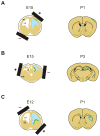In utero electroporation as a tool for genetic manipulation in vivo to study psychiatric disorders: from genes to circuits and behaviors
- PMID: 21551077
- PMCID: PMC3530425
- DOI: 10.1177/1073858411399925
In utero electroporation as a tool for genetic manipulation in vivo to study psychiatric disorders: from genes to circuits and behaviors
Abstract
Many genetic risk factors for major mental disorders have key roles in brain development. Thus, exploring the roles for these genetic factors for brain development at the molecular, cellular, and neuronal circuit level is crucial for discovering how genetic disturbances affect high brain functions, which ultimately lead to disease pathologies. However, it is a tremendously difficult task, given that most mental disorders have genetic complexities in which many genetic risk factors have multiple roles in different cell types and brain regions over a time-course dependent manner. Furthermore, some genetic risk factors are likely to act epistatically in common molecular pathways. For this reason, a technique for spatial and temporal manipulation of multiple genes is necessary for understanding how genetic disturbances contribute to disease etiology. Here, the authors will review the said technique, in utero electroporation, which investigates the molecular disease pathways in rodent models for major mental disorders. This technique is also useful to examine the effect of genetic risks at the behavioral level. Furthermore, the authors will discuss the recent progress of this technology, such as inducible and cell type-specific targeting, as well as nonepisomal genetic manipulation, which provide further availability of this technique for research on major mental disorders.
Conflict of interest statement
The authors disclosed no conflicts of interests with respect to the authorship and/or publication of this article.
Figures




Similar articles
-
A Pipeline using Bilateral In Utero Electroporation to Interrogate Genetic Influences on Rodent Behavior.J Vis Exp. 2020 May 21;(159). doi: 10.3791/61350. J Vis Exp. 2020. PMID: 32510510
-
Application of in utero electroporation and live imaging in the analyses of neuronal migration during mouse brain development.Med Mol Morphol. 2012 Dec;45(1):1-6. doi: 10.1007/s00795-011-0557-0. Epub 2012 Mar 20. Med Mol Morphol. 2012. PMID: 22431177 Review.
-
Animal models for schizophrenia via in utero gene transfer: understanding roles for genetic susceptibility factors in brain development.Prog Brain Res. 2009;179:9-15. doi: 10.1016/S0079-6123(09)17902-5. Epub 2009 Nov 20. Prog Brain Res. 2009. PMID: 20302813 Review.
-
In Vivo Targeting of Neural Progenitor Cells in Ferret Neocortex by In Utero Electroporation.J Vis Exp. 2020 May 6;(159). doi: 10.3791/61171. J Vis Exp. 2020. PMID: 32449731
-
Rapid and efficient genetic manipulation of gyrencephalic carnivores using in utero electroporation.Mol Brain. 2012 Jun 20;5:24. doi: 10.1186/1756-6606-5-24. Mol Brain. 2012. PMID: 22716093 Free PMC article.
Cited by
-
Developmental Alcohol Exposure Impairs Activity-Dependent S-Nitrosylation of NDEL1 for Neuronal Maturation.Cereb Cortex. 2017 Aug 1;27(8):3918-3929. doi: 10.1093/cercor/bhw201. Cereb Cortex. 2017. PMID: 27371763 Free PMC article.
-
Biallelic MED29 variants cause pontocerebellar hypoplasia with cataracts.Eur J Hum Genet. 2025 Jul 31. doi: 10.1038/s41431-025-01918-6. Online ahead of print. Eur J Hum Genet. 2025. PMID: 40745490
-
Npas3 regulates stemness maintenance of radial glial cells and neuronal migration in the developing mouse cerebral cortex.Front Cell Neurosci. 2022 Oct 13;16:865681. doi: 10.3389/fncel.2022.865681. eCollection 2022. Front Cell Neurosci. 2022. PMID: 36313621 Free PMC article.
-
[Establishment of a system for regulating the gene expression of embryonic mouse cerebral cortex neural stem cells by in utero electroporation].Zhongguo Dang Dai Er Ke Za Zhi. 2022 Sept 15;24(9):1061-1067. doi: 10.7499/j.issn.1008-8830.2204096. Zhongguo Dang Dai Er Ke Za Zhi. 2022. PMID: 36111727 Free PMC article. Chinese.
-
In Utero Electroporation for Manipulation of Specific Neuronal Populations.Membranes (Basel). 2022 May 11;12(5):513. doi: 10.3390/membranes12050513. Membranes (Basel). 2022. PMID: 35629839 Free PMC article. Review.
References
-
- Bai J, Ramos RL, Ackman JB, Thomas AM, Lee RV, LoTurco JJ. RNAi reveals doublecortin is required for radial migration in rat neocortex. Nat Neurosci. 2003;6(12):1277–83. - PubMed
-
- Bai J, Ramos RL, Paramasivam M, Siddiqi F, Ackman JB, LoTurco JJ. The role of DCX and LIS1 in migration through the lateral cortical stream of developing forebrain. Dev Neurosci. 2008;30(1–3):144–56. - PubMed
-
- Borrell V, Yoshimura Y, Callaway EM. Targeted gene delivery to telencephalic inhibitory neurons by directional in utero electroporation. J Neurosci Methods. 2005;143(2):151–8. - PubMed
-
- Cetin A, Komai S, Eliava M, Seeburg PH, Osten P. Stereotaxic gene delivery in the rodent brain. Nat Protoc. 2006;1(6):3166–73. - PubMed
Publication types
MeSH terms
Grants and funding
LinkOut - more resources
Full Text Sources
Medical

